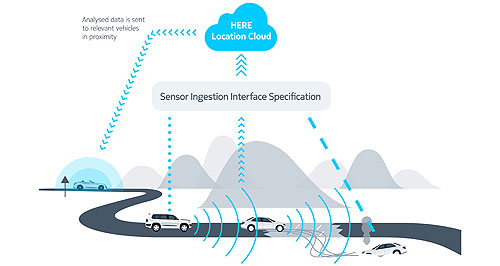News - General News - TechnologyDriverless vehicle data is Here and nowConnected: Intel is making a multi-pronged attempt to position itself at the head of the autonomous vehicle technology push. Vehicles that 'see around corners' closer as driverless data language gets tick29 Jun 2016 A EUROPEAN-developed data language that allows driverless cars to “see around corners” by sharing traffic and road information with fellow road users via the cloud took a step towards global adoption today when 11 automotive manufacturers and suppliers agreed to support it. Should it get the go ahead, the open-data system – called Sensoris by international mapping company Here, which revealed it last year – will allow millions of vehicles of all brands to pool driving data to provide real-time warnings of road conditions and traffic incidents for safer, more efficient autonomous driving. Companies to sign up to the protocol so far are Daimler, Aisin AW, Robert Bosch, Continental, Electrobit, Harman, Here, LG Electronics, NavInfo, Pioneer and Tom Tom. As Here is owned by Germany’s Big Three – Volkswagen (through Audi), Daimler and BMW – the approval of Volkswagen Group and BMW also appears to be a formality. The project is being championed by European public-private intelligent transport organisation Ertico ITS which has agreed to develop the software into a standardised interface for broad automotive use in place of the current fragmented range of part-developed systems. Here’s Asia-Pacific director Brent Stafford said driverless vehicles needed more than just sensors to provide a smooth and safe driving experience. “They need to communicate with all other vehicles on the road, sending, receiving, interpreting and responding to live route conditions in real-time,” he said. “By speaking a universal data language in the future, a German-built autonomous truck driving down an Australian highway will be able to warn a driverless Japanese sedan and US-made SUV following close behind to ‘slow down’ or ‘change lanes’ because of a wombat or mob of kangaroos near the road ahead. “Or perhaps a Holden parked in a busy neighbourhood could notify a BMW that has been circling nearby, that a parking spot has just become available in the adjacent space. “Sharing of the data can apply to all modes of transport including bikes, buses, trams, and trains, not just cars or trucks. “To get this right, there is simply insufficient information available from one car brand or model, and to enjoy the huge benefits of the new innovation and its reduction in emissions and congestion, we have to think both in a new scale and collaboratively.” Mr Stafford said Here had already mapped 90 per cent of Australia’s population areas with the high-definition machine-readable maps needed to test the new self-driving vehicles. “In addition to the various sensors such as lidar, cameras and ultrasonics required in driverless vehicles, the map is a critical virtual sensor which provides vital information to the vehicle about the road and terrain ahead and what it is likely to encounter over the hill or around the corner where the sensors cannot currently ‘see’,” he said. Although individual vehicles will provide and receive data via the Sensoris language, the cars will be anonymous to the computer system, heading off potential “big brother” fears. Mr Stafford said the vehicles would send and receive the information via 5G or LTE (Long Term Evolution) cellular phone connections. However, for immediate emergencies requiring a millisecond response – such as a vehicle ahead braking suddenly – a direct vehicle-to-vehicle signal would be sent, he said. Mr Stafford said that while a variety of data systems had been under development by OEMs (original equipment manufacturers), it was commonly agreed by the motor industry that a universal data language was essential. He said Here had been working for years on the data share language and technologies, putting it ahead of the curve and in a position to offer its system as the global standard. Although Ertico ITS is European centric, it has a track record of successfully introducing international protocols for other such protocols for intelligent transport innovations. As well, sister organisations such as ITS Australia are championing commonisation to avoid pitfalls of fragmented systems that hinder the introduction of such breakthrough technologies. Mr Stafford said he believed it was just a matter of time before other vehicle manufacturers, including those in the United States and Japan, came on board with Sensoris. To go with the data streaming language, Here is developing the required location cloud technology that can detect and process changes in the real world as they happen on roads in dozens of countries “on an industrial scale and at high quality”.  Read more |
Click to shareGeneral News articlesResearch General News Motor industry news |




















Facebook Twitter Instagram